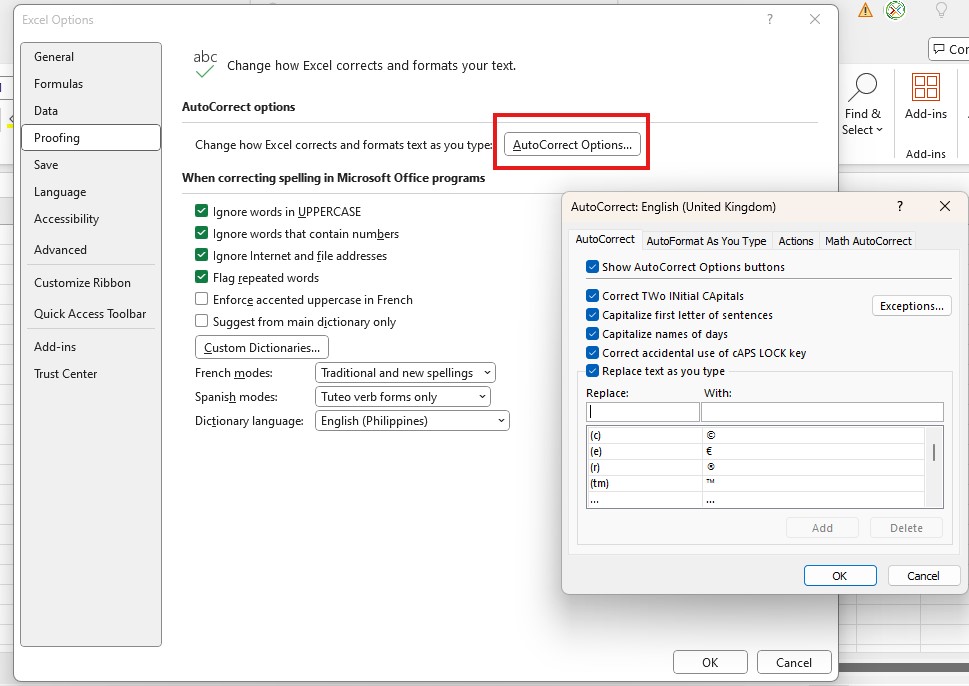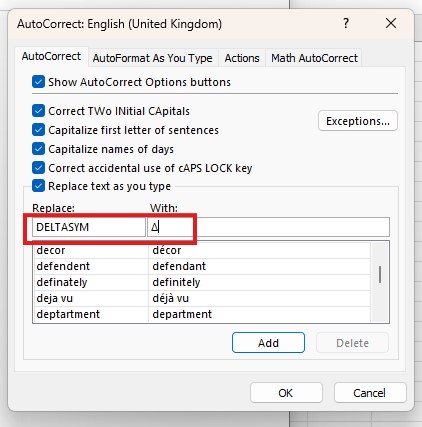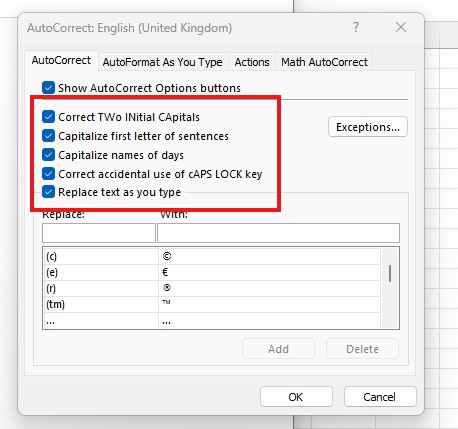Excel’s Autocorrect is a hidden gem for boosting productivity. Imagine, you’re working on a detailed spreadsheet and a series of typos start creeping in. That’s where Autocorrect jumps in, swiftly fixing misspellings and casoalerrors—before you spot them. It’s a feature that works diligently in the background, ensuring that everything you type comes out polished. To give you a glimpse, Autocorrect deals with common flubs like “teh” becoming “the,” or it capitalizes the first letter following a period.
Key Takeaways:
- AutoCorrect in Excel is a valuable tool for automatically correcting common typing errors, transforming abbreviations to full text, and managing the capitalization of words following a period. It is especially useful for fixing misspelled words and ensuring consistency in important work-related documents. Additionally, it can save time by expanding short phrases into full sentences, streamlining repetitive data entry tasks.
- The AutoCorrect feature can be customized according to user preference, and while most users may never need to adjust its default settings, knowing how to do so can be beneficial. For example, users can create shortcuts for frequently used, large formulas to save time, which is especially useful for those who regularly work with complex data sets.
- Despite its usefulness, it’s important to remember that AutoCorrect may not always function as intended, potentially changing correctly spelled words or technical terms. It’s vital to review changes made by AutoCorrect, and users can easily undo an AutoCorrect action by pressing Control + Z. To prevent future errors, users can also modify AutoCorrect settings to exclude specific words or phrases from being altered.
Table of Contents
Customizing Autocorrect to Your Workflow
You’re not stuck with Excel’s default settings—no, you can tailor Autocorrect to fit like a glove around your personal workflow. Dive into the Autocorrect options and you’ll uncover a treasure trove of customizable features. Do you often use industry-specific jargon or shorthand in your spreadsheets? Go ahead and program those pesky technical terms to automatically bloom into their full forms with just a few keystrokes.
It’s pretty simple: with a few clicks, add your own twist to the Autocorrect list. This can be a lifesaver for long, repetitive text blocks or complex vocabulary that becomes as easy as A-B-C to insert.

Efficient Data Entry with Excel Autofix
Speed Up Typing with Custom Abbreviations
When your day involves typing ‘International Widget Cooperation’ more times than you can count, custom abbreviations in Excel’s Autocorrect feature come to the rescue. By setting “IWC” to automatically expand to the full company name, you can shed minutes or even hours off your workweek. This isn’t just for company names—think of any lengthy term you use often, and assign it a shortcut. Your future self will thank you for the time reclaimed.
Remember to select abbreviations that are unique and not part of your standard text, to prevent accidental triggers. It’s a little change that can have a major impact on your daily tasks.
Inserting Special Symbols and Formulas Seamlessly
Tackling Excel’s equations can be as complex as a labyrinth, especially when it comes to inserting special symbols that are not readily available on your keyboard. But worry not, because Autocorrect brings the magic of efficiency to your fingertips. Imagine needing to insert the delta symbol frequently in your analysis. By setting up “DELTASYM” as a shortcut, hitting those keys will swiftly transform them into ?, making your data entry as smooth as silk.
Tailoring Autocorrect to Suit Your Needs
Adding Personal Touches to the Autocorrect List
Personalizing Excel’s Autocorrect list can feel like setting up your own secret codes. By adding your own set of shortcuts and expansions, you essentially create a unique dialect between you and your spreadsheet. This could be anything from turning “mths” into “months” to replacing “qrtr” with “quarterly report figures.” The possibilities are limitless and uniquely yours.
To get started, you just open the Autocorrect options and populate your personal list. It’s like teaching Excel your own language—one that streamlines your data entry and cuts down on the monotony of repetitive typing.
Preventing Excel from Overstepping with Autocorrect
Have you ever been a tad annoyed when Excel decides to ‘help’ by changing what you typed into something else entirely unintended? Well, you’re not alone. It’s important to keep Autocorrect on a leash, to ensure it doesn’t overstep and become more of a hindrance than a help. Sometimes keeping control means taking a step back and selectively turning off certain features that don’t fit your needs or adjusting its behavior for specific entries.
You can stop Excel from making certain changes by delving into the Autocorrect settings and unchecking the options that aren’t serving you. This way, you maintain the benefits of Autocorrect while curtailing its over-eager tendencies.

Common Pitfalls and How to Avoid Them
Turning Off Unwanted Autocorrect Functions
Sometimes the best move is to hit the off switch on certain Autocorrect functions that misfire more often than they help. If you find that Excel’s eagerness to correct leads to more frustration than relief, especially with specialized terminology or products codes, it’s a breeze to turn off these features.
Head over to the Options dialog box, select Proofing, and then ‘AutoCorrect Options.’ Here, you’ll find a list of features you can disable. For instance, unclicking the ‘Replace text as you type’ option can prevent those well-intentioned but misguided corrections. Keep in mind that this will also stop Excel from catching genuinely misspelled words, so use this power wisely.
Undoing Unintentional Changes Swiftly
Oops! Excel just autocorrected your entry, and you didn’t mean for it to happen. Rest easy, there’s a quick fix to reverse those automatic changes. If Excel decides to ‘correct’ something you didn’t want altered, simply hit Ctrl + Z right after the autocorrection, and voila, it reverts to what you initially typed. It’s a quick undo that keeps the flow of your work uninterrupted.
However, keep in mind that if you perform another action before hitting Ctrl + Z, you might need to manually correct the entry. It’s about having the reflex to immediately undo the unwanted change. So next time Excel jumps the gun with an autocorrection you didn’t ask for, remember, Ctrl + Z is your friend.
Advanced Tips for Power Users
Storing Complex Formulas with Ease
Imagine a world where the dread of re-entering long, complex formulas each time you need them is a thing of the past. Excel’s AutoCorrect allows you to store these brainy equations just like text expansions. For instance, you could assign the abbreviation “NetProfitCalc” to the formula that calculates net profit, and Excel will unfurl the full equation whenever you type it out.
Not only does this save you from the risk of errors that come with manual entry, but it also cuts down on the time spent typing or copy-pasting formulas across workbooks. Once set up, these stored formulas are at your beck and call, ready to spring into action with a few simple keystrokes.
Optimizing AutoCorrect for Speedy Data Compilation
In the race against the clock, optimizing AutoCorrect for speedy data compilation can be your turbo boost. Let’s say you’re compiling a massive dataset with recurring text. By setting up AutoCorrect shortcuts for these text strings, they materialize in your spreadsheet at the speed of thought. Think of acronyms, repetitive descriptions, or even complex terms that now take a fraction of a second to appear.
To really fine-tune this speedy process, consider the flow of your data entry and cater your AutoCorrect list to the phrases you hit most frequently. This creates a streamlined workflow where data practically enters itself, and you’re freed up to analyze, interpret, and make decisions—arguably the most crucial aspects of your work.
FAQ: Navigating the Ins and Outs of Excel Autofix
Can I completely disable Excel’s autocorrect?
Indeed, Excel allows you to turn off the Autocorrect feature completely. To do so, navigate to the ‘File’ tab, select ‘Options’, and then click on ‘Proofing’. Within the Proofing options, you’ll find a button for ‘AutoCorrect Options’. Uncheck the boxes for the features you want to disable, like ‘Replace text as you type’, and you’re all set. Remember, this will prevent Excel from autocorrecting any terms, including common typos.
How do I add my own entries to the Excel autocorrect list?
Adding your own entries to Excel’s Autocorrect list is straightforward. Select ‘File’ > ‘Options’ > ‘Proofing’ and then choose ‘AutoCorrect Options.’ In the resulting dialog, add your typo under ‘Replace’ and the correction under ‘With.’ Press ‘Add,’ confirm with ‘OK,’ and your custom entry will be ready to go!
Is there a way to quickly undo an unwanted autocorrect adjustment?
Yes, you can quickly undo an unwanted Autocorrect adjustment in Excel. Right after Autocorrect makes a change that you didn’t want, simply press ‘Ctrl + Z’ to revert it. Remember to do this immediately after the correction, as any other action may overwrite the undo history.
Are custom autocorrect changes applicable to all future Excel documents?
Custom Autocorrect changes in Excel are indeed applicable to all future documents. Once you personalize your Autocorrect settings, these modifications become part of your overall Office setup, ensuring that every new Excel document you work on will utilize these custom preferences for Autocorrect.
John Michaloudis is a former accountant and finance analyst at General Electric, a Microsoft MVP since 2020, an Amazon #1 bestselling author of 4 Microsoft Excel books and teacher of Microsoft Excel & Office over at his flagship MyExcelOnline Academy Online Course.









